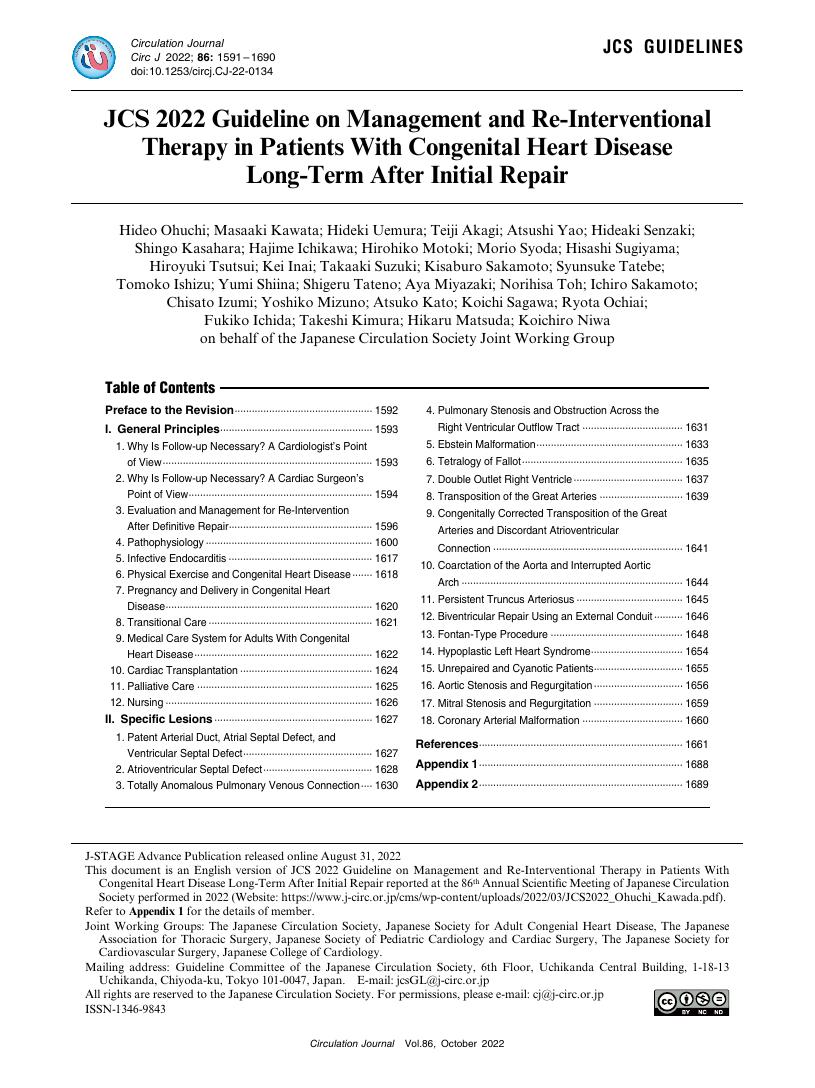- 著者
- Hideo Ohuchi Masaaki Kawata Hideki Uemura Teiji Akagi Atsushi Yao Hideaki Senzaki Shingo Kasahara Hajime Ichikawa Hirohiko Motoki Morio Syoda Hisashi Sugiyama Hiroyuki Tsutsui Kei Inai Takaaki Suzuki Kisaburo Sakamoto Syunsuke Tatebe Tomoko Ishizu Yumi Shiina Shigeru Tateno Aya Miyazaki Norihisa Toh Ichiro Sakamoto Chisato Izumi Yoshiko Mizuno Atsuko Kato Koichi Sagawa Ryota Ochiai Fukiko Ichida Takeshi Kimura Hikaru Matsuda Koichiro Niwa on behalf of the Japanese Circulation Society Joint Working Group
- 出版者
- The Japanese Circulation Society
- 雑誌
- Circulation Journal (ISSN:13469843)
- 巻号頁・発行日
- pp.CJ-22-0134, (Released:2022-08-31)
- 参考文献数
- 1071
- 被引用文献数
- 6
- 著者
- Shunsuke Tatebe Satoshi Yasuda Ryo Konno Yasuhiko Sakata Koichiro Sugimura Kimio Satoh Takashi Shiroto Satoshi Miyata Osamu Adachi Masato Kimura Yoshiko Mizuno Junko Enomoto Shigeru Tateno Hiromichi Nakajima Kotaro Oyama Yoshikatsu Saiki Hiroaki Shimokawa
- 出版者
- The Japanese Circulation Society
- 雑誌
- Circulation Journal (ISSN:13469843)
- 巻号頁・発行日
- pp.CJ-23-0383, (Released:2023-09-05)
- 参考文献数
- 37
- 被引用文献数
- 2
Background: Little is known about clinical or sociodemographic factors that influence health-related quality of life (HRQoL) in patients with adult congenital heart disease (ACHD).Methods and Results: We conducted a nationwide prospective cross-sectional multicenter study at 4 large ACHD centers in Japan. From November 2016 to June 2018, we enrolled 1,223 ACHD patients; 1,025 patients had an HRQoL score. Patients completed a questionnaire survey, including sociodemographic characteristics, and the 36-Item Short-Form Health Survey (SF-36). To determine factors associated with HRQoL, correlations between 2 SF-36 summary scores (i.e., physical component score [PCS] and mental component score [MCS]) and other clinical or sociodemographic variables were examined using linear regression analysis. In multivariable analysis, poorer PCS was significantly associated with 11 variables, including older age, higher New York Heart Association class, previous cerebral infarction, being unemployed, and limited participation in physical education classes and sports clubs. Poorer MCS was associated with congenital heart disease of great complexity, being part of a non-sports club, current smoking, and social drinking. Student status and a higher number of family members were positively correlated with MCS.Conclusions: This study demonstrates that HRQoL in ACHD patients is associated with various clinical and sociodemographic factors. Further studies are needed to clarify whether some of these factors could be targets for future intervention programs to improve HRQoL outcomes.
- 著者
- Tomoaki Murakami Yoko Horibata Shigeru Tateno Yasutaka Kawasoe Koichiro Niwa
- 出版者
- 一般社団法人 日本血管不全学会
- 雑誌
- Vascular Failure (ISSN:24324477)
- 巻号頁・発行日
- vol.4, no.2, pp.39-45, 2021-08-31 (Released:2021-09-08)
- 参考文献数
- 20
- 被引用文献数
- 1
Background:We previously reported enhanced pressure wave reflection in adult patients with congenital heart disease, which can result in high systolic blood pressure. Although hypertension could cause significant damage to vulnerable systemic ventricles, few studies have reported on blood pressure in adults with congenital heart disease thus far. The purpose of this study was to investigate the incidence and risk factors associated with hypertension in adult patients with congenital heart disease. Methods and Results:One-hundred and thirty-one adults with congenital heart disease were enrolled in this study. Brachial blood pressure was measured using an HEM-9000AI system (Omron Healthcare Co., Ltd., Kyoto, Japan). Patients with systolic/diastolic blood pressure ≥140/90 mmHg or those taking medication for hypertension were defined as hypertension. A systolic blood pressure ≥ +2 SD of systolic blood pressure in the age- and sex-matched general population was defined as high systolic blood pressure. The patients were aged 37.0 ± 15.0 years. Hypertension was observed in sixteen patients (16%), and logistic regression analysis revealed that the determinant of hypertension was age (years) (odds ratio [OR], 1.078; 95% confidence interval [CI], 1.029-1.129; p = 0.001). High systolic blood pressure was observed in twenty patients (20%). Logistic regression analysis revealed that the determinants of high systolic blood pressure were age (years) (OR, 1.072; 95%CI, 1.020-1.126; p = 0.016) and body mass index (kg/m2) (OR, 1.261; 95% CI, 1.054-1.508; p = 0.011). The body mass index in young patients (≤ 30 years) with high systolic blood pressure was remarkably high (31.2 ± 3.0 kg/m2). Conclusions:The incidence of high systolic blood pressure is high in adult patients with congenital heart disease. High systolic blood pressure is common in older patients and is associated with a high body mass index in young patients.
- 著者
- Hideo Ohuchi Masaaki Kawata Hideki Uemura Teiji Akagi Atsushi Yao Hideaki Senzaki Shingo Kasahara Hajime Ichikawa Hirohiko Motoki Morio Syoda Hisashi Sugiyama Hiroyuki Tsutsui Kei Inai Takaaki Suzuki Kisaburo Sakamoto Syunsuke Tatebe Tomoko Ishizu Yumi Shiina Shigeru Tateno Aya Miyazaki Norihisa Toh Ichiro Sakamoto Chisato Izumi Yoshiko Mizuno Atsuko Kato Koichi Sagawa Ryota Ochiai Fukiko Ichida Takeshi Kimura Hikaru Matsuda Koichiro Niwa on behalf of the Japanese Circulation Society Joint Working Group
- 出版者
- The Japanese Circulation Society
- 雑誌
- Circulation Journal (ISSN:13469843)
- 巻号頁・発行日
- vol.86, no.10, pp.1591-1690, 2022-09-22 (Released:2022-09-22)
- 参考文献数
- 1071
- 被引用文献数
- 6
